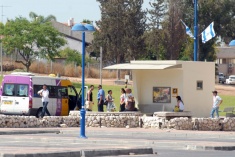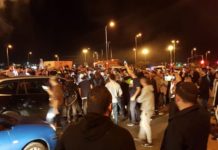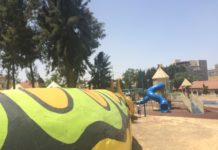
This journey however was the journey from, as the foreign media like to refer to it, ‘the western part of Jerusalem’ that is to say, not Arab East Jerusalem. This is the place I have lived since making Aliyah to Israel from England 13 months ago. I travelled to a small town in the South bordering the Gaza Strip in the Western Negev called Sderot. For the past 7 years Sderot has been under constant Qassam rocket fire from groups such as Fatah, Islamic Jihad and more recently Hamas. For the past 3 years, since handing back the whole of the Gaza Strip, an area captured during the 6 Day War of 1967, to the Palestinian Authority, there has been much soul searching amongst all levels of Israeli society. Suffice to mention the Jews that were encouraged by consecutive Israeli governments to settle, develop and work all of these areas and to cultivate the mainly barren land.
These same settler Jews succeeded against numerous odds. They made the land flourish and brought income and prosperity to the inhabitants including the majority of Palestinians living in these areas who also benefited from the rebirth of the Gaza Strip after 1967.
It had been widely predicted, mainly in the foreign media, that Jew would fight against Jew once the plan of disengagement would come to fruition. A plan conceived by former Prime Minister Ariel Sharon and culminated on August 15th 2005. The foreign media, not for the first time, was wrong. With the exception of a few isolated incidents, the Jewish residents of the Gaza Strip took their possessions and left for an uncertain future. Watched and even helped by fellow Jews in the Israeli Defence Forces, they embarked on a journey with no real idea of where they were heading or what the future had in store for them. For many of these settlers it was the second time around. The first had been the move from Yamit in the Sinai after the Menachem Begin deal, that gave Sinai to the Egyptians. This led to the cold peace that still remains in place to this day with Egypt.
Had this been the start of a new chapter in the history of the Middle East and in particular the Israeli Palestinian conflict, it may have at least been worth it. However within less than 2 years, the terrorist organisation Hamas had violently overthrown the Palestinian Authority in Gaza. They openly killed Fatah members in front of their families and in view of the watching media. At that time, unlike now, the media were still allowed to operate with a certain degree of normality and were able to report these images. Despite this, the media chose to show minimal information with no moral commentaries around the barbaric and savage acts being carried out by Hamas against the Fatah members. This was a vast contradiction to the way the media portrays the actions of the Israel Defence Forces.
After this bloodbath, that most of the world had chosen to ignore, the situation for the residents of Sderot and the surrounding communities became even more intolerable. They live with daily and sometimes hourly barrages of Qassam rockets with just 15 seconds to get to makeshift shelters once the Tzeva Adom (red alert) is sounded. This is due largely to the fact that Hamas is now able to operate in much closer proximity to these communities. In the past, the Gaza Strip had been a buffer zone. With the disengagement of the strip and no military presence, the success rate of the various crude rockets has a greater chance of hitting their civilian targets in the surrounding areas of sovereign Israel.
Conditions for the Palestinian residents of Gaza also deteriorated. Largely due to the Hamas guerrilla strategy and their Iranian funders, the Palestinian residents of the strip are caught in the middle of Hamas operations and IDF retaliations. Hamas use these defenceless people as pawns in their media propaganda knowing that retaliatory action will cause loss of innocent lives. This is the reason why many rockets are launched from such densely populated areas within the strip.
My aim is to put context and perspective on the events that have led to this situation. On a personal note, as a photojournalist with over 20 years experience within national, regional and communal print media publications, I wanted to portray how life continues, on a daily basis, for the citizens of this region. They live against the backdrop of sensationalist and at times, irresponsible Photoshop journalism, where 24 hour media and websites publish unedited and unverified information. This is the alternative war currently being won by media savvy terrorists who are taking advantage of companies more interested in getting ‘the exclusive inside scoop’ than depicting factually correct information.
As a child, I remember being taught to cross the road. Looking left, looking right, looking left again and if there is no oncoming traffic, crossing the road. Arriving in Sderot, the first thing I looked out for, and I am sure many other visitors do the same as they arrive, is seeing how far they are from the nearest shelter. Checking that, if the red alert sounds, 15 seconds is enough time to get inside the nearest shelter before a Qassam rocket explodes into the first thing it connects with.
The residents who still remain here are all aware of each shelter along their daily routes to work and dropping their children at nursery and school. These times have been used by terrorists on the other side of the border to cause maximum anxiety, stress and fear. They have managed to do this in abundance. They also tend to fire in the late afternoon for the same reasons.
This is my 3rd time in Sderot and the 1st time for a period longer than just one day. The first thing that I remember thinking when I arrived here for the first time back in January 2008, was how the town is like so many other towns in Israel. This reminded me specifically of a Moshav called Kfar Mordechai. A small village near Gedera approximately 15 minutes from here and a place where I have some of my happiest childhood memories, being with cousins who still live there. I was visiting Sderot back in January with a group from the Christian Embassy in Jerusalem who donated reinforced bus shelters to the town.
However once you look around there is a big difference. Unlike most towns in Israel where you will see normal sights of people going about their daily lives, walking, sitting at cafes, playing in the park and riding around on bicycles, here you are struck by the fact that hardly anyone is outside for too long. The people seem very tense and in a hurry to do whatever it is they need to do and return to a safe indoor area. This is not a way people should have to live.
On my arrival I was very relieved when I saw 3 shelters. I was constantly thinking and looking for the next one should the siren sound. Thankfully, so far while I have been in Sderot, the sirens have not sounded. However I know that will probably change very quickly. The difference for me is that I am here by choice. The majority of the people here do not have that luxury. I was asked if I was nervous when I told my family of my plans. Being an experienced photojournalist I have been in many dangerous situations and my answer is always the same. We have fear for a reason and that reason is that we recognise danger and work out the best way to deal with it. I worry about people who would not be nervous going into this situation.
Additionally a cousin, who arrived in Israel 60 years ago, asked me if this was a good time to be going to Sderot. Is there ever a good time? I explained my reasons for being in Sderot and the belief that I and many other people seem to have here. Ultimately what happens to us all is in G-d’s hands.
Most houses in Sderot do not actually have proper shelters. Residents are told to head for a room where the least damage could be done in the event of a direct hit, not very reassuring!!
I was in Nahariyah at the start of the second Lebanon War. During that time I experienced being under missile attack. On that occasion I was in a basement with 3 generations of my family including my nephew who was four and a half years old at the time. I was holding him while the Katyushas fell all around us. My feelings now are that at least the rest of my family will not have to experience it here. In Sderot, they have been living through it day after day for seven years. Just because it is not my family on this occasion, it is someone’s family. This could just as easily be any other town or city in Israel in the future. This is why everything has to be done now to stop this situation and make people aware of it.
I arrived just before the holiday of Shavuot celebrating Moses receiving the Torah on Mount Sinai. It is also a celebration of the harvest. With farmers in this area being shot at everyday while they try to harvest the land, this seems even more relevant.
In other towns and cities in Israel, the day leading into the Sabbath or a Jewish festival has a very special and unique atmosphere. A feeling of togetherness and family, irrelevant of religious background. When I arrived in Sderot, on Erev Chag people were experiencing what they refer to as, ‘the fake quiet’. This means that, although there had been no Tzeva Adom and no Qassam rockets in the past two days, people knew it was only a matter of time before it started again. Real psychological warfare at its best!
As I waited for Anav from the Sderot Media Centre I had the opportunity to sit by the Shuk in the centre of town a few meters from the bus station. There were a few people either leaving or arriving in town, some people getting flowers for their loved ones and others trying to get home as quickly as possible.
Two things happened that I noticed. The first was a man in a wheelchair, wheeling himself in the road. I couldn’t help but wonder what he would do if the siren sounded. It’s hard enough for able bodied people to get to somewhere safe in 15 seconds following the siren sounding to a Qassam landing. What happens with people who are not able bodied? It’s something that had not even occurred to me before and something else that is not really given a second thought by the majority of people.
The second thing is something that will stay with me for the rest of my life. A woman who was probably younger than she looked was agitated by me taking pictures and shouted at me in Hebrew. I explained to her in my very limited Hebrew that I was not photographing her and not to worry. At this point she asked me where I was from and what I was doing in Sderot. I explained to her the reasons for my visit and she wished me luck and apologized for shouting at me. I understood her anxiety. Anyone living in these conditions would become anxious. She turned to her shopping bags and produced a box of nectarines which she split in two. She then gave me half of the contents of the box in a token of friendship.
This is one of the least affluent places in Israel, yet this complete stranger had shown such generosity towards another complete stranger.











